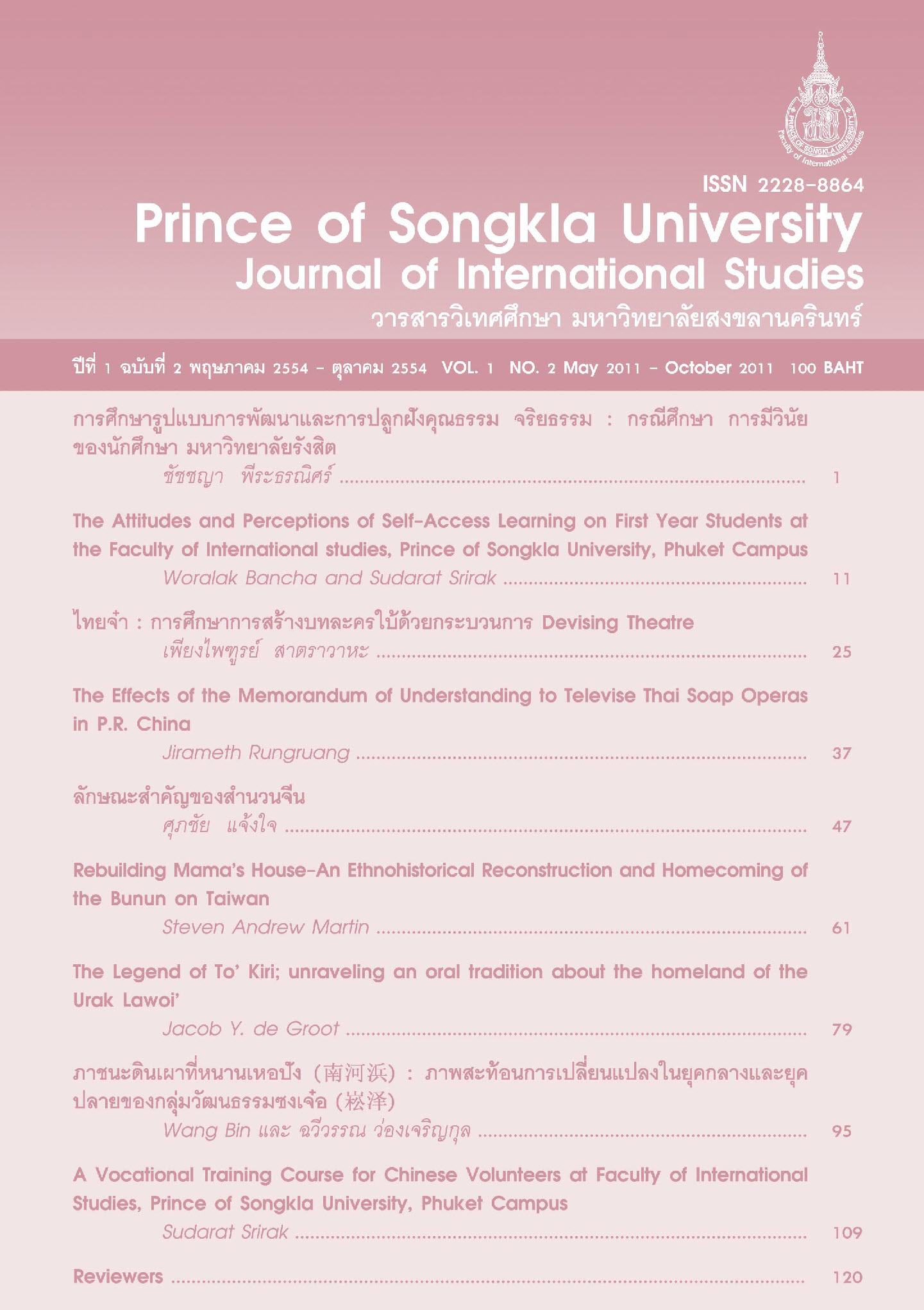The Attitudes and Perceptions of Self-Access Learning on First Year Students at the Faculty of International Studies, Prince of Songkla University, Phuket Campus
Main Article Content
Abstract
In order to promote self-access learning, learners attitudes and perceptions towards this method play a significant role. In the first and second semesters of the academic year 2010, the Faculty of International Studies, Prince of Songkla University, Phuket Campus, initially offered an English clinic where self-study lessons and a teacher as consultant were available. This study was aimed to investigate attitudes and perceptions of 90 FIS first-year students towards self-study, learning materials, an English clinic, and consultants. Data was collected through close- and open-ended questionnaires and in-depth interviews. The results mainly demonstrated that most of the participants held a positive attitude towards self-access learning and they spent at least half an hour self-studying per lesson. They perceived that self-study lessons and an English clinic were useful to a moderate degree while the quality of consultants was high. It is recommended that materials for self-access learning should be designed pertaining to students interest and proficiency in order to motivate them to study and create positive attitudes toward their self-access learning.
Article Details
Statements and opinions expressed in articles herein are those of the authors and do not necessarily reflect the position of the editors or publisher.
Article, information, text, image, etc. which are published in Journal of International Studies, belong to Journal of International Studies. If anybody or any organization would like to use part or whole of them, they must receive written permission from Journal of International Studies before usage.
References
Cotterall, S. (1995). Readiness for autonomy: investigating learner beliefs. System, 23 (2), 195-205.
Dickinson, L (1995). Autonomy and motivation: a literature review. System, 23 (2), 165-174.
Dulyarat, K. (2002). The Relationship between English language achievement, attitudes and class participation of high and low achiever. Unpublished master's thesis, Prince of Songkla University, Thailand.
Gardner, D. & Miller, L. (1999). Establishing self-access. Cambridge: Cambridge University Press.
Gardner, D. & Miller, L. (1999). Beliefs about self-access learning: Reflections on 15 years of change. Studies in Self-Access Learning Journal, 1 (3), 161-172. man, 1903). 1861-1972
Koyalan, A. (2009). The evaluation of a self-access centre: A useful addition based teaching? System, 37, 731-740. addition to class
Krashen, S.D. & Terrell, T.D. (1995). The natural approach: language acquisition in classroom. New York: Phoenix. question in the
Lightbown, P. & Spada, N. (1993). How languages are learned. Oxford: Oxford University Press.
Liftle, D. (1995). Leaming as dialogue: the dependence of learner autonomy on teacher autonomy. System, 23 (2), 175–182.
Liuolienė, A. & Metiūnienė, R. (2006). Second Language Learning Movtivation. Santalka. Filologija. Edukologija, 14 (2), 93-98. Retrieved February 11, 2011, from http://www.vgtu.lt/upload/filosof_zurn/a_liuoliene_metiuniene_filologija_nr2.pdf
Morrison, B. (2008). The role of the self-access centre in the tertiary language learning process. System, 36, 123–140.
Pickens, J. (2005). Attitudes and perceptions. Retrieved February 11, 2011, from http://healthadmin.jbpub.com/Borkowski/chapter3.pdf.
Rukthong, A. (2008). Readiness for autonomous language learning: Thai university learners' beliefs about EFL learning and use of learning strategies. Unpublished master's thesis, Mahidol University, Thailand.
Sanprasert. N. (2010). The application of a course management system to enhance autonomy in learning English as a foreign language. System. 38. 109-123.


